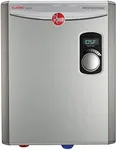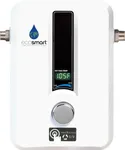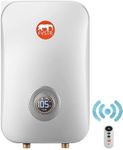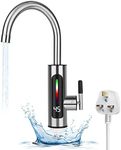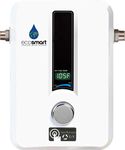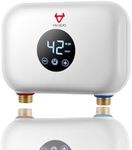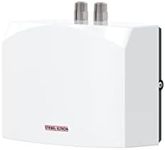Buying Guide for the Best Electric Tankless Water Heater
Choosing the right electric tankless water heater can significantly impact your comfort and energy efficiency. These devices heat water on demand, which means you won't run out of hot water and you can save on energy costs. However, selecting the right model involves understanding several key specifications to ensure it meets your household needs. Here’s a guide to help you navigate through the essential specs and make an informed decision.Flow Rate (GPM)Flow rate, measured in gallons per minute (GPM), indicates how much hot water the heater can produce at a given time. This is crucial because it determines whether the heater can meet your household's hot water demands. For instance, a higher GPM is necessary for larger households or if you plan to run multiple hot water outlets simultaneously (like a shower and a dishwasher). Typically, a flow rate of 3-5 GPM is suitable for small to medium households, while larger homes may require 6-10 GPM or more.
Temperature RiseTemperature rise refers to the difference between the incoming water temperature and the desired output temperature. This is important because it affects the heater's ability to provide sufficiently hot water. If you live in a colder climate where the incoming water temperature is low, you'll need a heater that can handle a higher temperature rise. Generally, a temperature rise of 50-70 degrees Fahrenheit is adequate for most households, but you may need more if your incoming water is particularly cold.
Power (kW)The power rating, measured in kilowatts (kW), indicates the electrical power the heater uses to heat the water. This is important for understanding the heater's efficiency and capacity. Higher kW ratings typically mean the heater can provide more hot water and heat it faster. For small households or single-point applications, a lower power rating (around 10-15 kW) may suffice. Larger households or whole-house applications might require a higher power rating (20-30 kW or more).
Energy EfficiencyEnergy efficiency measures how effectively the heater converts electrical energy into hot water. This is important for reducing energy consumption and lowering utility bills. Look for models with high energy efficiency ratings, often indicated by a percentage. Most modern electric tankless water heaters have efficiency ratings of 90% or higher. Choosing a model with a higher efficiency rating can lead to significant savings over time.
Installation RequirementsInstallation requirements include the electrical and plumbing specifications needed to install the heater. This is important to ensure compatibility with your home's existing infrastructure. Check the voltage and amperage requirements, as well as the type of circuit breaker needed. Some models may require professional installation due to their complexity. Make sure your home can accommodate the installation requirements to avoid additional costs or complications.
Size and SpaceThe physical size of the heater and the space available for installation are important considerations. Tankless water heaters are generally compact, but you need to ensure there is enough space for proper ventilation and maintenance. Measure the installation area and compare it with the dimensions of the heater. This will help you choose a model that fits comfortably in your designated space without causing any issues.
Warranty and SupportWarranty and customer support are important for ensuring long-term satisfaction with your purchase. A good warranty can provide peace of mind and protect you from unexpected repair costs. Look for models with comprehensive warranties that cover both parts and labor. Additionally, consider the availability of customer support and service centers in your area. This can be crucial if you encounter any issues with your heater.
